NATURE'S MIRACLES: BIOLUMINESCENCE, SARKLING SEAS AND GLOWING SHROOMS!
Fireflies are wondrous creatures. But, thanks to our recklessness and careless attitude, we are forcing them towards extinction. Nevertheless, if some of us are still willing to take a walk down a dirt road, particularly after sundown, we would be mesmerised by their vibrant dance, almost magically choreographed by Mother Nature. In search of a mate, the male fireflies fly around, flashing blips of light, in response to which, the female flashes back at a potential mate. Due to their unique light-emitting ability, which serves as a perfect example for bioluminescence, they have rightfully acquired the name of glowworms or lightning bugs.
History of Bioluminescence: Since the dawn of human civilization, men have observed that living beings such as fireflies, mushrooms, certain marine organisms, and even rotten wood possess the unique ability to produce a light of their own. The early sailors were sometimes stupefied to see tiny sparks in agitated seawater and a blue glow across the coast. Numerous instances of such bioluminescence, i.e., light originating from living organisms or animal light, can be found throughout the recorded history of all the major civilisations, starting from ancient China, Greece, Rome, India, Africa and the Polynesian Islands.
The great Aristotle recorded detailed observations about bioluminescence in marine fauna, in addition to about a hundred and eight insects. He also observed that dead fish and decaying wood glowed in the dark while a glass of seawater when stirred could light up with tiny sparks. He also noticed that the light emitted from living organisms was not accompanied by heat, but was cold to touch. Hence the name cold light. A few centuries later, Pliny the Elder in his 'Naturalis Historia', compiled several instances of luminous fireflies, molluscs and jellyfish.
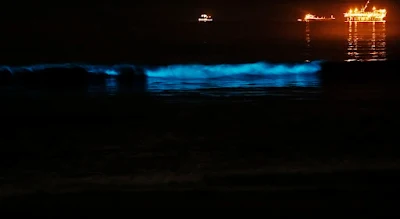 |
| When the sea lights up/Image Credits: makelessnoise CC BY 2.0, via Wikimedia Commons |
In the sixteenth century, the study of bioluminescence reached a great height, following the publication of 'De Lunariis' by Conrad Gessner. Athanasius Kircher published a similar book on luminescence, where he proposed that some creatures acquired their light-emitting ability to be seen by other creatures. The pioneer of science, Sir Francis Bacon performed some experiments with rotten wood and revealed that its luminescence increased with the application of oil or water. In 1647, a Danish physician, Thomas Bartholin, published all his observations of luminescence in 'De Luce Animalium' and obtained the general idea of light being present in everything. One of the most significant discovery was however done by Robert Boyle, when he observed that luminescence from living organisms decreased in the absence of air(later oxygen).
The phosphorescence of the sea intrigued many great minds, and in 1747, Benjamin Franklin proposed that the fire of the sea might be due to the presence of extremely small animals or insects, more precisely 'animalcules'. In 1753, Henry Baker, a British naturalist confirmed the emission of light from animalcules, now known as dinoflagellates, which are single celled eukaryotic organisms, and belong to the category of algae.
Sir Charles Darwin was also fascinated by the sparks seen in agitated sea water. While on a voyage aboard the H.M.S Beagle, across the coast of Tenerife on January 6, 1832, observed that,
''...The sea was luminous in specks and in the wake of the vessel, of a slightly milky colour. When the water was put in a bottle, it gave out sparks....''.
The Bioluminescent Compound, Luciferin: During the late nineteenth century, Raphael Dubois, a French pharmacologist, carried out extensive research on the bioluminescence of click beetles and a clam-like species known as Pholas dactylus. He prepared a paste by crushing the light-emitting organs from the beetles and mixed it with cold water, where the luminescence faded away gradually. On preparing an extract using hot water, the light emission ceased immediately. When mixed together, the two extracts were found to be luminescent once again. From these experiments Dubois concluded that bioluminescence was the resulted from the oxidation of a specific compound and an enzyme. The compound became known as luciferin, meaning light bearer, and the enzyme, luciferase.
As mentioned earlier, bioluminescence is essentially a chemiluminescent reaction between two compounds-luciferin and luciferase, in the presence of air, i.e., oxygen. Recent studies indicate that oxygen reacts with luciferin and produces oxyluciferin in an excited state, which then drops to its preferred ground state of low energy, thereby releasing light in the process.
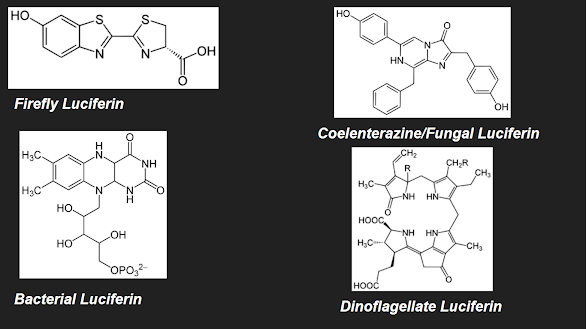 |
| Chemical structure of some luciferins/Image Credits: Author's Computer |
Firefly Luciferin: It is the compound responsible for the emission of the yellow to a little greenish light in most beetle species, such as the common firefly, railroad, star-worm and the click beetles. It is believed that luciferin, when oxidized by luciferase, yields 1,2-dioxetane, which further decomposes to carbon dioxide and excited ketones, and emit light. A firefly can control its light by regulating the amount of oxygen available to the compounds required for the aforesaid chemical reaction. Fireflies emit light in the wavelength ranging from 510 nm(i.e., green) to 670 nm(i.e., red). Crystalline luciferin, synthesized in the laboratory, are fluorescent that can absorb UV radiations and re-emit light in the wavelength of 530 nm.
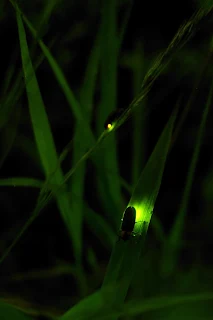 |
| That green flash from our childhood/Image Credits: Takashi Ota, https://www.flickr.com/photos/takot |
 |
| Some lonely mushroom/Image Credits: Barisandi, CC BY-SA 4.0, via Wikimedia Commons |
The earliest records of the glow of mycelium present in decaying wood, dubbed as Foxfire can be traced back to the writings of Aristotle, who described the light to be cold to touch unlike fire. But fungal bioluminescence is perplexing indeed, as no one knows the exact need for them to give off light.
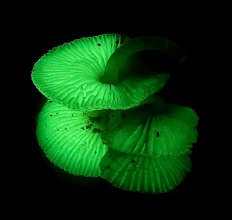 |
| Another alien mushroom/Image Credits: https://www.flickr.com/photos/gusveitch |
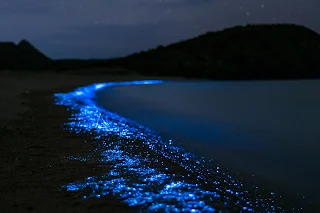 |
| The beach sparkles due to the presence of millions of dinoflagellates/Image Credits: Pixabay |
 |
| One scary looking fish-the Anglerfish/Image Credits: Masaki Miya et al., CC BY 2.0, via Wikimedia Commons |
Why Glow For Nature's Sake?
Bioluminescence has repeatedly evolved(30-40 times independently) mainly among the marine lifeforms, and to some extent, terrestrial creatures. In fish alone, bioluminescence might have evolved 27 times. From genome sequencing of fungi, recent research suggests that the first bioluminescent mushroom could have appeared 160 million years ago. However, marine bioluminescence had to appear before terrestrial bioluminescence as the former creatures were in desperate need of some light. Although we do not know how these organisms became bioluminescent, it is clear that their light-generating ability serves as a tactical advantage in the scheme of natural selection. While some species use it for catching prey, attracting mates, self-defence, communication, there are others where this ability is of no practical use.
- Catching Prey: Some species light themselves up to lure prey directly towards their mouth, or in different scenarios, light up their surroundings so as to see their prey. The deep-sea anglerfish has a bioluminescent light-emitting gland that looks like a filament protruding from their heads. It has been observed that the gland lights up as a result of a symbiosis between certain bacteria species that cannot synthesize the chemicals necessary for luminescence on their own. The angler fish supplies the chemicals, while the bacteria light up and help the fish to catch its prey.
- Attracting Mates: Apart from searching for prey, bioluminescence could also be used for attracting potential mates. In the case of the deep-sea angler fish, the females light up to attract the males. As already mentioned, for fireflies, the females flash in response to their suitable males. The fireflies also serve as a good example of communication with bioluminescence.
- Defence: Sometimes, a sudden strong and bright flash of light can scare away possible predators, like the shrimp Acanthephyra purpurea can throw up a cloud of bioluminescent material and make the attacking creature vulnerable to its own predators. The firefly squid has its body covered with tiny light-producing organs which light up in a way to match with the intensity of surrounding light. This counter-illumination technique makes itself invisible to its predators.
- Reproduction: At first it was believed that fungal bioluminescence might have been an accident of evolution. But that could not explain why the fungi only glowed at night and maintained a circadian rhythm. Recently, scientists have suggested that the fungi developed this ability to disperse their spores via the insects that are attracted towards the greenish glow.
Humans And Bioluminescence: Bioluminescence is an active field of research, and in the future, living lights could replace our present sources of artificial lighting. With the help of genetic engineering, humans are trying to incorporate the light-producing ability of fireflies and mushrooms into plants with the aim of developing glow-in-the-dark trees which would ultimately reduce the need for street lights. It could also be a potential source of ultimate green energy.
References:
- https://www.goldbio.com/articles/article/The-History-of-Luciferin-and-Luciferase-discovery-timeline#_Toc49782166
- https://www.nationalgeographic.org/encyclopedia/bioluminescence/
- https://ocean.si.edu/ocean-life/fish/bioluminescence
- https://www.smithsonianmag.com/science-nature/why-bioluminescence-evolved-be-red-light-and-blue-180969435/
- Harvey, Edmund Newton. A History Of Luminescence; From The Earliest Times Until 1900. The American Philosophical Society, Philadelphia.


Comments
Post a Comment